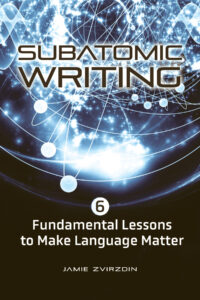‘Subatomic Writing’ Author
Challenging Old Notions
of Science Communication

By TED MEBUST
OLNEY, MD – Sitting alone in the back corner of the Richfield Springs Public Library, science writer and researcher Jamie Zvirzdin diligently crafted her latest publication, presumably with coffee in hand. It was October of 2018, six months since Zvirzdin and her son, Max, were forced to flee from Managua, Nicaragua following an outbreak of political upheaval that had flooded the capital’s streets with police and protestors. Her husband, Andrew, remained stationed there as one of the U.S. Embassy’s emergency personnel.
“I was teaching astronomy at the local college, and the president Ortega, started breaking up peaceful protests. It escalated very quickly, like within a week,” Zvirzdin explained.
Her students at Universidad Americana de Managua were attempting to complete their semesters while police battered protestors, invaded homes and, in some cases, kidnapped the students’ parents and friends.
“It’s been hard to grapple with that. I’m not here to solve the world, we can’t. The most we can do is work with other people and groups to communicate well and bring about peace.”
One of her good friends, Dora María Téllez, remains imprisoned.
Six months after their exodus, Zvirzdin and Max had made their way from Utah, where they had taken asylum, to family in Richfield Springs while awaiting Andrew’s return.
In the library, Zvirzdin was drafting the initial ideas for “Subatomic Writing: Six Fundamental Lessons to Make Language Matter,” a guide to making science writing more accessible. Her message draws from a decade’s-worth of work proofreading CRC Press textbooks on engineering, computer programming, optics, mathematics, statistics, and astrophysics, acting as managing editor for the NGO Atomium Culture, and publishing a myriad of articles for “The Atlantic” and “Orion Magazine,” among other publications. Currently, she also works as a cosmic ray researcher for the Telescope Array Project at the University of Utah and teaches science writing in the master’s degree Science Writing Program at Johns Hopkins University.
“There’s this mystical, invisible divide that people feel is present between language arts and science,” described Zvirzdin. “But it doesn’t have to be there, and what I’m trying to show in ‘Subatomic Writing’ is that some of our best scientists—including James Clerk Maxwell, John Dalton, and Lise Meitner—knew how to write well and inclusively by writing for their audience, rather than trying to one-up their reader.”
“Subatomic Writing,” Zvirzdin said, is similar to a reference guide and includes six basic lessons to improve all kinds of science writing, exploring grammar and punctuation conventions but also offering “that special element that most science writers don’t get to study very much”—rhythm and emphasis. She has been teaching a course on the concept for the past four years, which has garnered enormous interest at JHU. Given the broad swath of experience amongst her students, some having an entire career as scientists and others just entering the industry, Zvirzdin has had to “speak to both ends of the science and language arts spectrum.”
“Think about how difficult and boring most of those scientific textbooks are, and I know myself because I had to proof-read them for 10 years [while working at CRC Press]. I know what formal science writing is supposed to look like, but it’s not working…we have agreed on certain conventions and to a degree, we need to allow those conventions to change, evolve, and be more inclusive.”
Poor science communication, Zvirzdin believes, contributes to broader controversies surrounding science within our society today.
“I think that part of the anti-science movement we have right now is because people are very tired of feeling stupid, when it’s actually the scientists’ fault for not effectively communicating.”
However, the issue, she admits, is not so easily solved.
“A lot of scientists and science writers are told that they need to write one way, which is reinforced by textbooks with stilted language, so they think ‘this is what a scientist needs to do to be a good scientist.’”
Yet some of the greatest science minds of all time were able to communicate their ideas in a more accessible way, Zvirzdin pointed out.
“James Clerk Maxwell knew history and literature. He could cite different allusions to commonly understood literature in order to connect what he was saying to his reader. One example I share in the book is how he talks about how particles are like billiard balls. This is a great way to teach. This is how we learn as humans, by equating something we know with something we don’t know. I believe that’s been forgotten today.”
Zvirzdin sees “Subatomic Writing” as a good primary textbook for creative writing courses and a secondary textbook for any science course.
Zvirzdin and her family have settled in Olney, Maryland for the last four years, but frequently visit central New York to see family. While working at JHU, she is pursuing a master’s degree in physics, ahead of the family’s relocation to Frankfurt, Germany this coming June, as her husband’s latest post for the Foreign Service.
She plans to speak on “Subatomic Writing” and the state of science communication further in Washington, D.C. at an annual meeting of the American Association for the Advancement of Science on March 5. In addition, Zvirzdin welcomes any interest from area groups in having her discuss the book going forward.

